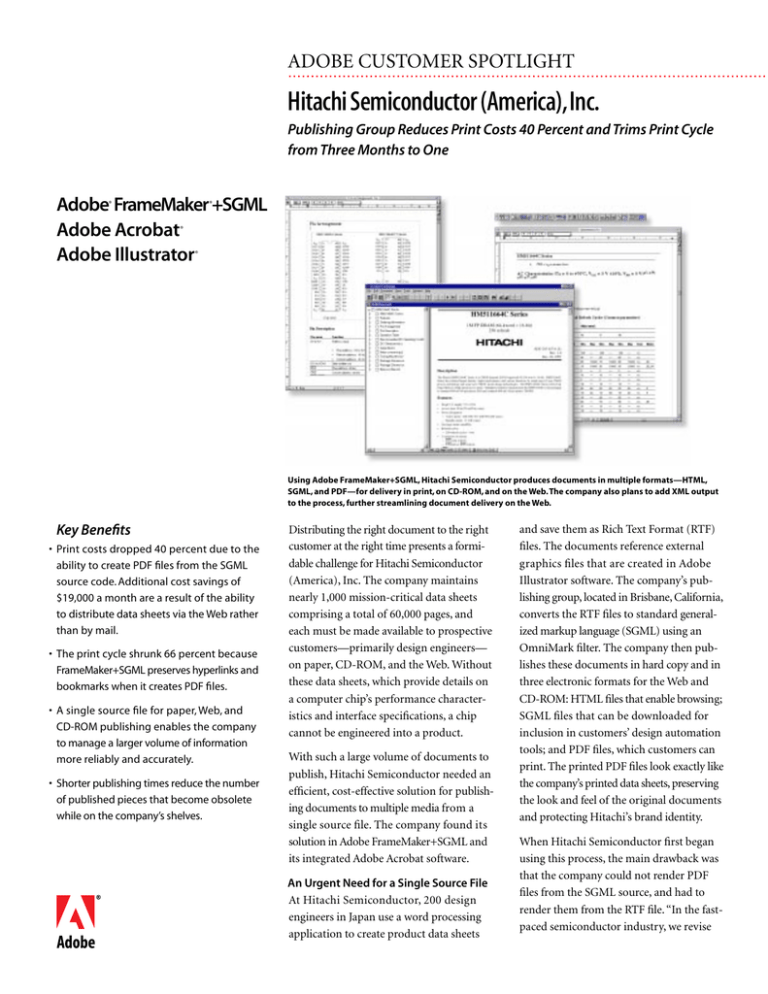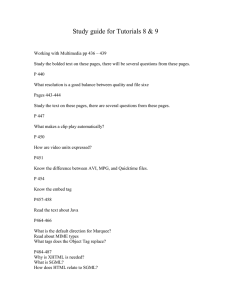
ADOBE
CUSTOMER SPOTLIGHT
..........................................................................................................
Hitachi Semiconductor (America), Inc.
Publishing Group Reduces Print Costs 40 Percent and Trims Print Cycle
from Three Months to One
Adobe FrameMaker +SGML
Adobe Acrobat
Adobe Illustrator
®
®
®
®
Using Adobe FrameMaker+SGML, Hitachi Semiconductor produces documents in multiple formats—HTML,
SGML, and PDF—for delivery in print, on CD-ROM, and on the Web. The company also plans to add XML output
to the process, further streamlining document delivery on the Web.
Key Benefits
• Print costs dropped 40 percent due to the
ability to create PDF files from the SGML
source code. Additional cost savings of
$19,000 a month are a result of the ability
to distribute data sheets via the Web rather
than by mail.
• The print cycle shrunk 66 percent because
FrameMaker+SGML preserves hyperlinks and
bookmarks when it creates PDF files.
• A single source file for paper, Web, and
CD-ROM publishing enables the company
to manage a larger volume of information
more reliably and accurately.
• Shorter publishing times reduce the number
of published pieces that become obsolete
while on the company’s shelves.
Distributing the right document to the right
customer at the right time presents a formidable challenge for Hitachi Semiconductor
(America), Inc. The company maintains
nearly 1,000 mission-critical data sheets
comprising a total of 60,000 pages, and
each must be made available to prospective
customers—primarily design engineers—
on paper, CD-ROM, and the Web. Without
these data sheets, which provide details on
a computer chip’s performance characteristics and interface specifications, a chip
cannot be engineered into a product.
With such a large volume of documents to
publish, Hitachi Semiconductor needed an
efficient, cost-effective solution for publishing documents to multiple media from a
single source file. The company found its
solution in Adobe FrameMaker+SGML and
its integrated Adobe Acrobat software.
An Urgent Need for a Single Source File
At Hitachi Semiconductor, 200 design
engineers in Japan use a word processing
application to create product data sheets
and save them as Rich Text Format (RTF)
files. The documents reference external
graphics files that are created in Adobe
Illustrator software. The company’s publishing group, located in Brisbane, California,
converts the RTF files to standard generalized markup language (SGML) using an
OmniMark filter. The company then publishes these documents in hard copy and in
three electronic formats for the Web and
CD-ROM: HTML files that enable browsing;
SGML files that can be downloaded for
inclusion in customers’ design automation
tools; and PDF files, which customers can
print. The printed PDF files look exactly like
the company’s printed data sheets, preserving
the look and feel of the original documents
and protecting Hitachi’s brand identity.
When Hitachi Semiconductor first began
using this process, the main drawback was
that the company could not render PDF
files from the SGML source, and had to
render them from the RTF file. “In the fastpaced semiconductor industry, we revise
our documents an average of four times a
year, so version control is challenging
enough with 970 publications,” says Bob
Tabone, program manager for marketing
communications. “With 970 times three
versions—Web, CD-ROM, and paper—it
would be nightmarish. Lacking a single
source file, we could not have a high
confidence level that we were producing
PDF files from the same version as the
SGML file. That was unacceptable from a
quality standpoint.”
Another drawback of rendering PDF files
from RTF was the need to manually re-add
bookmarks and links, a process that required
an average of five hours per document. At
40 documents per month, this meant Hitachi
Semiconductor spent 200 person-hours
re-creating information that already existed
in another format. Long publishing lead
times left the company with out-of-date
documents: Approximately 30 percent of
published pieces became obsolete while on
the company’s shelves.
FrameMaker+SGML Software Creates
SGML, HTML, and PDF Files
With its adoption of FrameMaker+SGML
software in late 1996, Hitachi Semiconductor
was able to produce PDF files directly from
the SGML source simply by choosing the
Save As PDF command. The PDF files are
published to the Web and delivered to print
vendors for print-on-demand publication.
“With PDF, we can deliver documents anywhere, exactly as intended,” says Tabone.
By preserving hyperlinks and automatically
creating bookmarks, FrameMaker+SGML
eliminates a labor-intensive process. In addition, the company can provide print
vendors with production-ready files because
FrameMaker+SGML handles composition
and pagination of the data sheets and
automatically generates indexes and
tables of contents. “FrameMaker+SGML
Adobe Systems Incorporated
345 Park Avenue, San Jose, CA 95110-2704 USA
Adobe Systems Pty. Ltd.
Level 5, 18-20 Orion Road, Lane Cove, NSW 2066, Australia
“With shrinking product design cycles,
faster time-to-information and
resulting faster time-to-market are
not just nice benefits for our customers, they are a business imperative. By
eliminating steps from production,
FrameMaker+SGML supports a
mission-critical process.”
—Bob Tabone,
Program Manager, Marketing Communications,
Hitachi Semiconductor (America), Inc.
has become one of the most important
tools in our publishing suite,” says Tabone.
Time Savings and Reduced Costs
By using FrameMaker+SGML to create
PDF files directly from the SGML source
code, Hitachi was able to reduce its print
costs 40 percent and decrease its print cycle
66 percent—from three months to one
month. “With shrinking product design
cycles, faster time-to-information and resulting faster time-to-market are not just
nice benefits for our customers, they are a
business imperative. By eliminating steps
from production, FrameMaker+SGML
supports a mission-critical process,” says
Tabone. The company accrues additional
savings by being able to convert existing
documents to PDF files at no additional
cost. Its customers download an average of
25,000 product data sheets as PDF files
each month, saving $25,000 in postage.
XML Support Positions Company
for Future
While FrameMaker+SGML solved the initial
challenge—creating a single source file for
multiple delivery mechanisms—SGML,
itself, still imposed certain limitations for
Hitachi. “SGML is so esoteric and abstract
that software developers have difficulty
developing tools for it,” says Tabone. “The
tools they do develop tend to be large and
slow, making SGML ill-suited for Web
delivery. In addition, no Web tools are
available to allow customers to take advantage of an SGML document’s rich data format.
For example, there is nothing today that
will enable our customers to search our
document set for all chips with performance
in a certain range.”
The answers to the limitations of SGML
have arrived in the form of XML output,
available in a coming release of
FrameMaker+SGML. “XML provides the
structure of SGML without its complexity,”
says Tabone. An added benefit for the
company, whose authors are in Japan, is
that XML has integrated double-byte
character support.
Tabone expects that XML will augment the
initial savings from FrameMaker+SGML.
He calculates that XML will reduce printing
costs another 15 percent, and shave another
two weeks from lead time for a 50 percent gain.
“Adobe FrameMaker+SGML software and
XML will make electronic, highly automated
publishing available to a much broader
spectrum of people because they reduce
the cost of entry, ongoing costs, and time
to market,” says Tabone.
Hitachi Semiconductor (America), Inc.
Systems At-A-Glance
Hardware:
Apple Macintosh
PCs running Microsoft® Windows® 95
UNIX® workstations
Software:
Adobe Acrobat
Adobe FrameMaker+SGML
Adobe Illustrator
Document Management:
Documentum Document Management System
Adobe, the Adobe logo, Acrobat, FrameMaker, and Illustrator are trademarks of Adobe Systems Incorporated. Microsoft and Windows are either
registered trademarks or trademarks of Microsoft Corporation in the United States and/or other countries. Apple and Macintosh are trademarks of
Apple Computer, Inc. registered in the U.S. and other countries. UNIX is a registered trademark of The Open Group. All other trademarks are the
property of their respective owners.
Adobe Systems Europe Limited
Adobe House, Mid New Cultins, Edinburgh EH11 4DU
Scotland, United Kingdom
This spotlight contains illustrations of how customers use Adobe products and the results achieved. Many factors contributed to the results and
benefits described. Adobe and/or its customers do not guarantee the same or similar results for other customers.
Adobe Systems Co., Ltd.
Yebisu Garden Place Tower
4-20-3 Ebisu, Shibuya-ku, Tokyo 150-6017 Japan
© 1998 Adobe Systems Incorporated. All rights reserved. Printed in the USA. BC1165 8/98
World Wide Web
www.adobe.com

